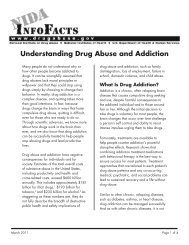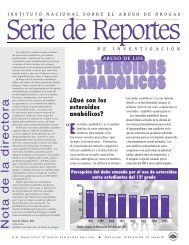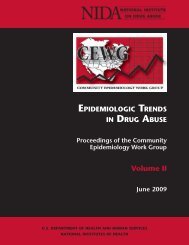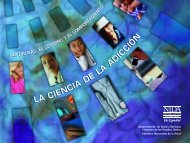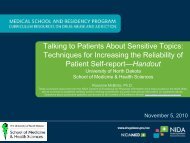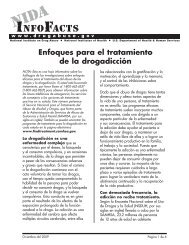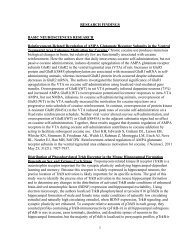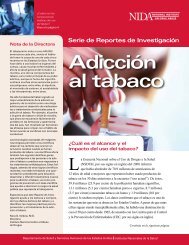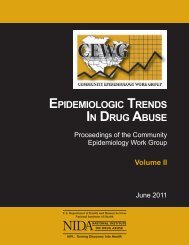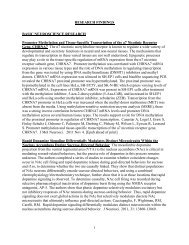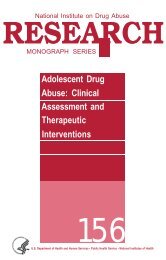CEWG January 09 Full Report - National Institute on Drug Abuse
CEWG January 09 Full Report - National Institute on Drug Abuse
CEWG January 09 Full Report - National Institute on Drug Abuse
You also want an ePaper? Increase the reach of your titles
YUMPU automatically turns print PDFs into web optimized ePapers that Google loves.
EpidEmiologic TrEnds in drug AbusE: HigHligHTs And ExEcuTivE summAry<br />
were female. The use of inhalants also remained<br />
stable, and 13 percent of users were female. Alcohol<br />
c<strong>on</strong>tinued as a primary drug of abuse. At the<br />
nati<strong>on</strong>al level, alcohol was the main substance<br />
reported by forensic services, followed by cocaine<br />
in the central and southern regi<strong>on</strong>s, and heroin in<br />
the north. It was also the main substance identified<br />
at admissi<strong>on</strong> to emergency departments. Ten<br />
percent of alcohol users in treatment centers were<br />
females. Northern border regi<strong>on</strong> patterns: The<br />
northern border regi<strong>on</strong>, including the states of<br />
Baja California, S<strong>on</strong>ora, Chihuahua, Coahuila,<br />
Nuevo León, and Tamaulipas, showed a very different<br />
pattern of substance use when compared<br />
with the rest of the country. While 46 percent of<br />
admissi<strong>on</strong>s to treatment centers for the rest of<br />
the country in 2008 were due to alcohol, the primary<br />
drug at the border was heroin (29 percent<br />
of admissi<strong>on</strong>s), followed by methamphetamine<br />
(21 percent). Alcohol accounted for <strong>on</strong>ly 19 percent<br />
of admissi<strong>on</strong>s at the border. There were no<br />
differences in the age or gender distributi<strong>on</strong> of<br />
admissi<strong>on</strong>s between the border and the rest of<br />
the country. By states, methamphetamine and<br />
heroin were the more frequent primary drugs in<br />
Baja California and S<strong>on</strong>ora; heroin and cocaine<br />
were the main <strong>on</strong>es in Chihuahua; and cocaine<br />
and alcohol were the main drugs in Coahuila,<br />
Nuevo Le<strong>on</strong>, and Tamaulipas. The percentage of<br />
admissi<strong>on</strong>s to treatment centers reporting ever<br />
having used intravenous drugs has decreased<br />
c<strong>on</strong>stantly during the past 10 years, from 64 percent<br />
in 1998, down to 32 percent in 2007 and the<br />
first half of 2008.<br />
Data Source: <str<strong>on</strong>g>Nati<strong>on</strong>al</str<strong>on</strong>g> Epidemiological<br />
Surveillance System of Addicti<strong>on</strong>s (SISVEA),<br />
2008: During the first half of 2008, 790 treatment<br />
centers c<strong>on</strong>tributed informati<strong>on</strong> to SISVEA. They<br />
were mostly n<strong>on</strong>governmental, run by n<strong>on</strong>profit<br />
organizati<strong>on</strong>s, and many of them follow a selfhelp<br />
approach based <strong>on</strong> Alcoholics An<strong>on</strong>ymous<br />
12-step programs. Also during this period, 31 Juvenile<br />
Detenti<strong>on</strong> Centers and Forensic Services in 20<br />
states reported to SISVEA. One hundred and sixteen<br />
emergency departments in 17 states c<strong>on</strong>ducted<br />
surveys of substance use in admissi<strong>on</strong>s. Informati<strong>on</strong><br />
for this report came from 152 cities in all 32 states.<br />
74<br />
Proceedings of the Community Epidemiology Work Group, <str<strong>on</strong>g>January</str<strong>on</strong>g> 20<str<strong>on</strong>g>09</str<strong>on</strong>g>



